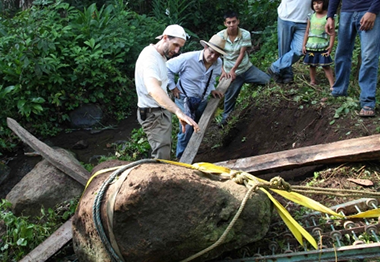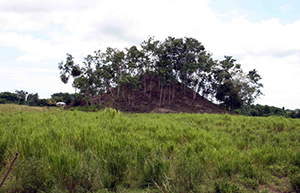A Kingdom Fully Realized
An anthropologist unearths an ancient Mesoamerican network of cities.
 |
|
Robert Rosenswig (hat on backwards) works with his team on the discovery and excavation of a carved stela (monument) at Izapa.
|
ALBANY, N.Y. (Oct 31, 2018) — The region comprising pre-Hispanic Mesoamerica is one of a handful of locations in the world where urban centers were independently established. One of the largest of these centers was the southern Mesoamerica city of Izapa. Up to now, however, while the political, administrative and religious life of Izapa was understood, the kingdom surrounding and feeding off it remained an unknown.
No longer, due to the work of an archeological team led by Anthropology Professor Robert M. Rosenswig. Due also, as Rosenswig comprehensively describes in his published writings, to the 21st century use of Light Detection and Ranging technology (lidar) to complement his team’s traditional pedestrian survey efforts.
In a series of recently published peer-reviewed articles, Rosenswig shows that, during Mesoamerica’s Formative Period in the 1st millennium BC, Izapa became the capital of an integrated kingdom comprising dozens of lower-order monumental centers, each with a political hierarchy and distinct urban life. Arranged around the Izapa Kingdom’s perimeter, the smaller cities shared organized programs of public works, economic interactions and military defenses for the capital.
Before his team’s research, there was no evidence of Izapa’s regional organization. Through use of lidar, Rosenswig was able to see into earthen mounds — raised areas containing houses, temples and other evidence of human occupation — to see everything from homes to temples in the network of smaller cities. Traditional excavation by his team then uncovered ceramics and other evidence of the cities’ lifestyles.
 |
|
The largest mound — some 60 feet high — in Las Viudas, the second largest center in the Izapa kingdom.
|
His most recently published article: “Lidar reveals the entire kingdom of Izapa during the first millennium BC,” (co-authored by Ricardo López-Torrijos) appears in the October issue of Antiquity. Next month, in a special section of the journal Ancient Mesoamerica that Professor Rosenswig co-organized, ten articles will be published documenting the latest new evidence from Izapa.
Rosenswig, who has directed archeological projects in Mexico and Central America for more than two decades, writes that such findings at Izapa were impossible before the use of lidar. He began applying lidar technology in 2011 on his two National Science Foundation- funded Izapa Regional Settlement Projects, of which he was principal investigator.
“The lidar did an amazing job of mapping out the mounds, their relationship, organization and orientation,” he said. “By the time we were on the second NSF grant, we had a pretty good idea of what Formative Period urban sites looked like. The ceramics confirmed the date of occupation of the sites.”
One of the articles to appear in the Special Section of Ancient Mesoamerica published by Rosenswig is co-authored by two UAlbany Ph.D. student-researchers, Rebecca Mendelsohn and Yahaira Núñez Cortés. Rosenswig and Mendelsohn also co-authored a recent article on the Classic Period (300-900 AD) occupation of Izapa in Latin American Antiquity.
Last Friday’s release of Rosenswig’s article in Antiquity on the Izapa Kingdom drew immediate scholarly interest. The study was featured in this Monday’s issues of LiveScience, “Hidden Monuments and Cookie-Cutter 'Suburbs' Discovered in Ancient Izapa Kingdom,” which included an extensive interview with Rosenswig, and Atlas Obscura, “The Ancient Mesoamerican City That Spawned Copies of Itself.”
Rosenswig's ongoing research on Mesoamerica includes a new three-year NSF award for research in the tropical lowlands of northern Belize. The grant, "The Role of Environmental Variation in the Appearance of Agricultural Domesticates," will reconstruct the human occupation and forest floral species diversity that occurred in that region from 4000-1000 BC, in order to examine the origins of food production in relation to climate change and evolving tropical forest ecology.
Current graduate students Antonio Martínez, Yahaira Nuñez-Cortes and Morgan Marx will accompany him to Belize on the project during the summer of 2019.
![]() For more news, subscribe to UAlbany's RSS headline feeds
For more news, subscribe to UAlbany's RSS headline feeds
A comprehensive public research university, the University at Albany-SUNY offers more than 120 undergraduate majors and minors and 125 master's, doctoral and graduate certificate programs. UAlbany is a leader among all New York State colleges and universities in such diverse fields as atmospheric and environmental sciences, business, education, public health,health sciences, criminal justice, emergency preparedness, engineering and applied sciences, informatics, public administration, social welfare and sociology, taught by an extensive roster of faculty experts. It also offers expanded academic and research opportunities for students through an affiliation with Albany Law School. With a curriculum enhanced by 600 study-abroad opportunities, UAlbany launches great careers.


